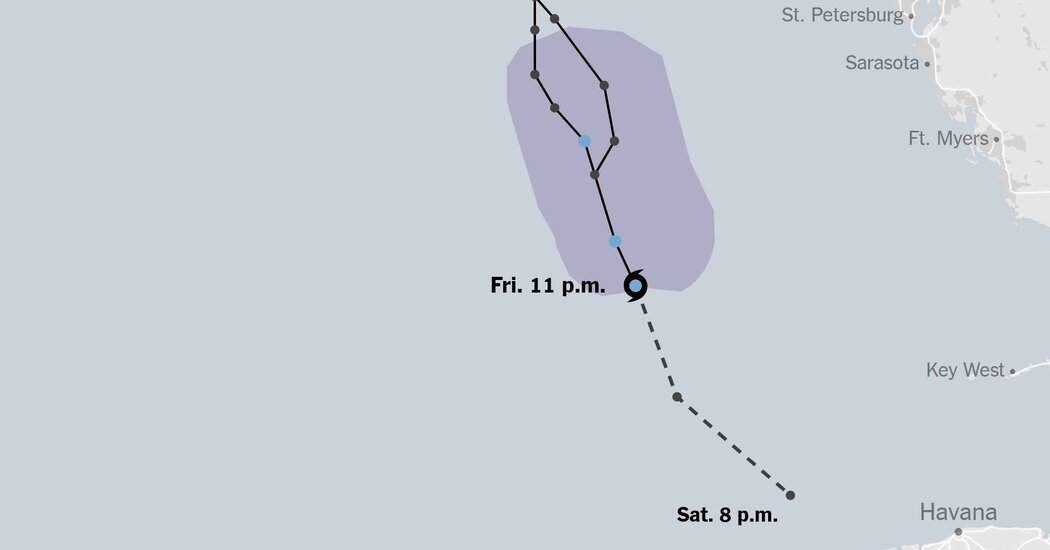Tropical Storm Arlene formed in the Gulf of Mexico on Friday, making it the first named storm of the 2023 Atlantic hurricane season.
Arlene was 240 miles west of Fort Myers, Fla., Friday afternoon and was moving southeast toward Cuba at seven miles per hour, the National Hurricane Center said in an advisory. There were no coastal watches or warnings in effect, the Hurricane Center said.
The storm had sustained winds of 40 m.p.h., with higher gusts. Tropical disturbances that have sustained winds of 39 m.p.h. earn a name. Once winds reach 74 m.p.h., a storm becomes a hurricane, and at 111 m.p.h., it becomes a major hurricane.
Arlene is technically the second tropical cyclone to reach tropical storm strength this year. The Hurricane Center announced in May that it had determined that a storm that formed off the northeastern United States in mid-January was a subtropical storm, making it the Atlantic’s first cyclone of 2023. However, the storm was not retroactively given a name, making Arlene the first named storm in the Atlantic basin this year.
The Atlantic hurricane season started on June 1 and runs through Nov. 30.
In late May, the National Oceanic and Atmospheric Administration predicted that there would be 12 to 17 named storms this year, a “near-normal” amount. There were 14 named storms last year, after two extremely busy Atlantic hurricane seasons in which forecasters ran out of names and had to resort to backup lists. (A record 30 named storms took place in 2020.)
However, NOAA did not express a great deal of certainty in its forecast this year, saying there was a 40 percent chance of a near-normal season, a 30 percent chance of an above-normal season and another 30 percent chance of a below-normal season.
There were indications of above-average ocean temperatures in the Atlantic for this season, which could fuel storms, and the potential for an above-normal West African monsoon. The monsoon season produces storm activity that can lead to some of the more powerful and longer-lasting Atlantic storms.
But forecasters also expect El Niño, the intermittent climate phenomenon that can have wide-ranging effects on weather around the world, to develop this year. That could reduce the number of Atlantic hurricanes.
“It’s a pretty rare condition to have the both of these going on at the same time,” Matthew Rosencrans, the lead hurricane forecaster with the Climate Prediction Center at NOAA, said in May.
In the Atlantic, El Niño increases the amount of wind shear, or the change in wind speed and direction from the ocean or land surface into the atmosphere. Hurricanes need a calm environment to form, and the instability caused by increased wind shear makes those conditions less likely. (El Niño has the opposite effect in the Pacific, reducing the amount of wind shear.) Even in average or below-average years, there is a chance that a powerful storm will make landfall.
As global warming worsens, that chance increases. There is solid consensus among scientists that hurricanes are becoming more powerful because of climate change. Although there might not be more named storms overall, the likelihood of major hurricanes is increasing.
Climate change is also affecting the amount of rain that storms can produce. In a warming world, the air can hold more moisture, which means a named storm can hold and produce more rainfall, like Hurricane Harvey did in Texas in 2017, when some areas received more than 40 inches of rain in less than 48 hours.
Researchers have also found that storms have slowed down, sitting over areas for longer, over the past few decades.
When a storm slows down over water, the amount of moisture the storm can absorb increases. When the storm slows over land, the amount of rain that falls over a single location increases. In 2019, for example, Hurricane Dorian slowed to a crawl over the northwestern Bahamas, resulting in a total rainfall of nearly 23 inches in Hope Town during the storm.
Other potential effects of climate change include greater storm surge, rapid intensification and a broader reach of tropical systems.

